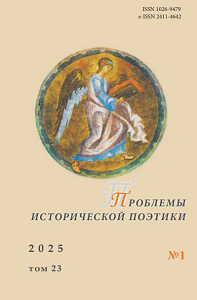Библейская мифопоэтика в литературном сценарии «Первороссияне» О. Ф. Берггольц
Biblical Mythopoetics in the Screenplay “The First Russians” by O. F. Bergholz
Author(s): Natalya А. ProzorovaSubject(s): Christian Theology and Religion, Cultural history, Studies of Literature, Russian Literature, Biblical studies, Film / Cinema / Cinematography
Published by: Петрозаводский государственный университет
Keywords: O. F. Bergholz; screenplay; The First Russians; Pervorossiyane; poetics of the title; commune; poetics of space; biblical cedar; Sabaoth; Efimiya; name semantics; Kitezhsky concept; Avvakum;
Summary/Abstract: In the screenplay “The First Russians” (“Pervorossiyane,” 1965), Bergholz reinterpreted the history of the creation of the first Russian agricultural commune in Altai by St. Petersburg workers, which she first creatively mastered in the poem “Pervorossiysk” (1950). She filled the text with biblical symbols, mythopoetic images and new characters. The place where the relocated workers choose to create a commune is described in the text as a “legendary valley” with “biblical cedars” which in the Psalter are associated with the righteous. Biblical allusions can be traced in the image of Uncle Lesha the cannon founder, who escorted the migrant communards on their way: according to the description, the worker resembles the god of Нosts (Sabaoth), who sends his heavenly messengers into the world. Obsessed with the idea of social justice, the First Russians die as martyrs for it: the scenario is permeated by the metaphor of the bonfire, which establishes a connection with the figure of the Old Believer Protopope Avvakum. The spiritual make-up of the communards is reflected as in a mirror in the “iconographic face” of Efimiya, the daughter of the Old Believer Theodosius, who opposes the First Russians. The idea of the commune as an ideal social structure is comprehended by Bergholz through the Kitezh concept. St. Petersburg workers, drawing a plan of the future settlement of Novorossiysk, see it “through the water.” Novorossiysk, set on fire by the Cossacks, appears to the communard Vasily Gremyakin submerging into a reservoir, just as the mythical Kitezh-grad descends into the waters of Svetloyar Lake. The text illustrates the integration of the author’s religious and mythological consciousness with the communist worldview. Bergholz builds a national image of the world built around the Christian worldview and the Soviet model of social justice. The analysis is carried out using Bergholz’s diary entries and the transcript of the script discussion meeting at the “Lenfilm” Studio. Bergholz’s informative notes from the period of her work on the script and a transcript containing a polemic about biblical allusions in the text allowed to place more precise accents in the interpretation of the work.
Journal: Проблемы исторической поэтики
- Issue Year: 23/2025
- Issue No: 1
- Page Range: 251-271
- Page Count: 21
- Language: Russian

